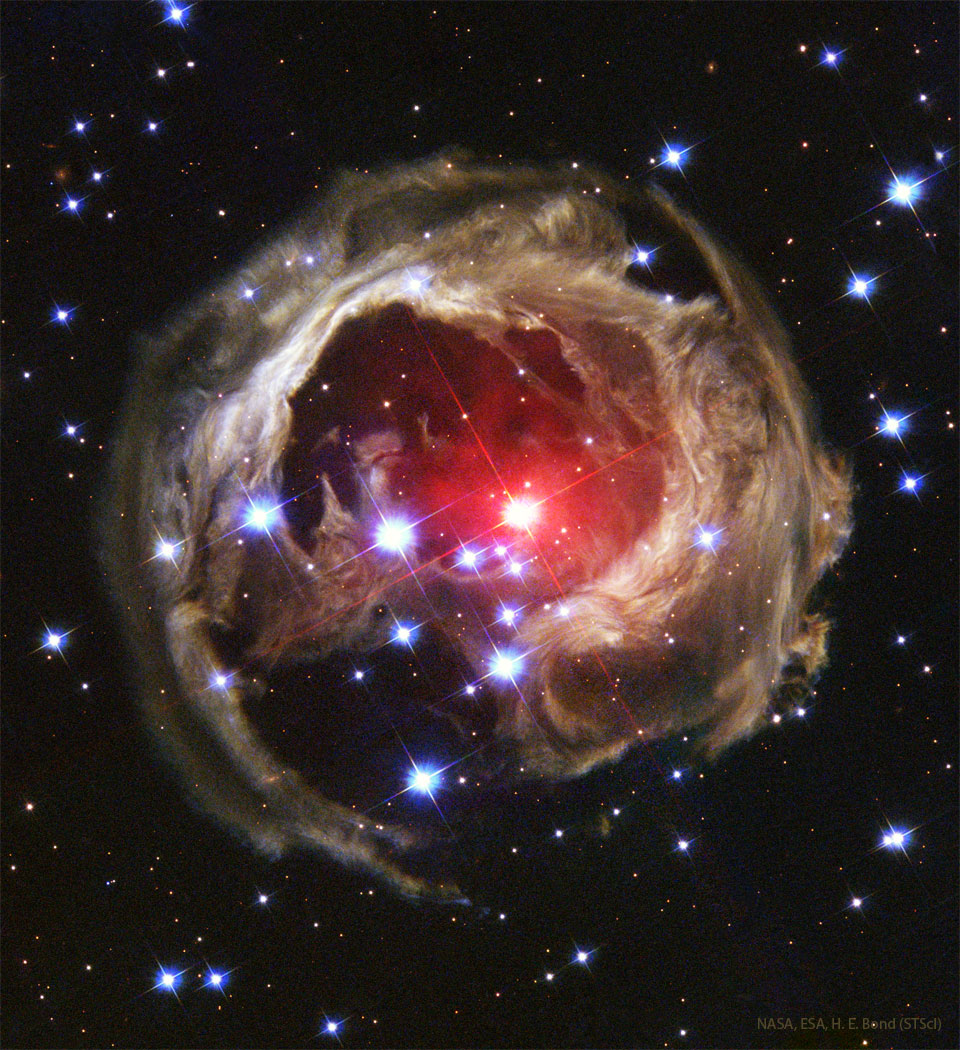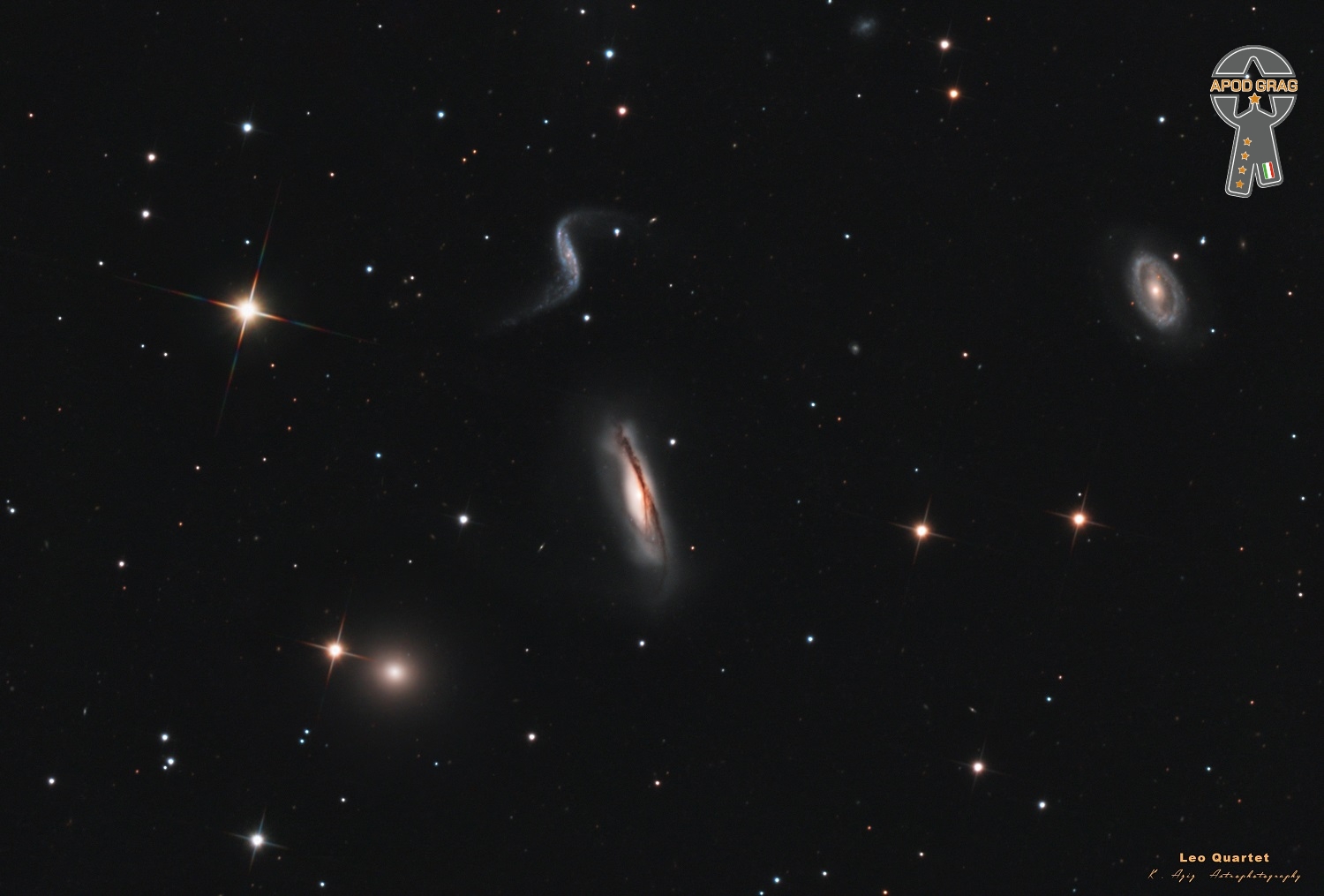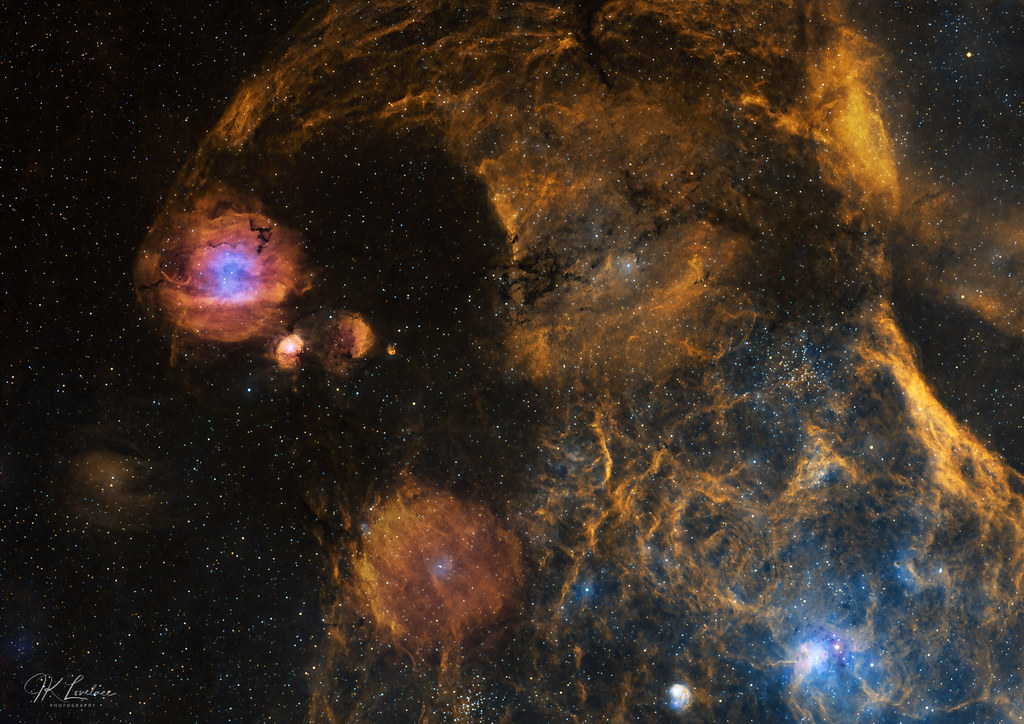Blog
For reasons unknown, star V838 Mon‘s outer surface suddenly greatly expanded with the result that it became one of the brighter stars in the Milky Way Galaxy in early 2002. Then, just as suddenly, it shrunk and faded. A stellar flash like this had never been seen before — supernovas and novas expel matter out into space. Although the V838 Mon flash appears to expel material into space, what is seen in the featured image from the Hubble Space Telescope is actually an outwardly expanding light echo of the original flash. In a light echo, light from the flash is reflected by successively more distant surfaces in the complex array of ambient interstellar dust that already surrounded the star. V838 Mon lies about 20,000 light years away toward the constellation of the unicorn (Monoceros), while the light echo above spans about six light years in diameter.

Samuel Lawrence Taylor (June 26, 1942 – August 19, 2019) was an American bass guitarist, best known for his work as a member of Canned Heat from 1967. Before joining Canned Heat he had been a sessionbassist for The Monkees and Jerry Lee Lewis. He was the younger brother of Mel Taylor, long-time drummer of The Ventures.
more...Gilberto Passos Gil Moreira (born 26 June 1942), known professionally as Gilberto Gil(Brazilian Portuguese: [ʒiwˈbɛʁtu ˈʒiw]), is a Brazilian singer-songwriter and politician, known for both his musical innovation and political activism. From 2003 to 2008, he served as Brazil’s Minister of Culture in the administration of President Luiz Inácio Lula da Silva. Gil’s musical style incorporates an eclectic range of influences, including rock, Brazilian genres including samba, African music, and reggae.
more...Reginald “Reggie” Workman (born June 26, 1937 in Philadelphia, Pennsylvania) is an American avant-garde jazz and hard bop double bassist, recognized for his work with both John Coltrane and Art Blakey.
Early in his career, Workman worked in jazz groups led by Gigi Gryce, Donald Byrd, Duke Jordan and Booker Little. In 1961, Workman joined the John Coltrane Quartet, replacing Steve Davis. He was present for the saxophonist’s Live at the Village Vanguard sessions, and also recorded with a second bassist (Art Davis) on the 1961 album, Olé Coltrane. Workman left Coltrane’s group at the end of the year, following a European tour.
In 1962, Workman joined Art Blakey‘s Jazz Messengers (replacing long-time Blakey bassist Jymie Merritt), and worked alongside Freddie Hubbard, Wayne Shorter, and Cedar Walton for most of this period. Workman left Blakey’s group in 1964.
more...Robert David Grusin (born June 26, 1934) is an American composer, arranger, producer, and pianist. He has composed many scores for feature films and television, and has won numerous awards for his soundtrack and record work, including an Academy Award and ten Grammy Awards. He is the co-founder of GRP Records.
Grusin was born in Littleton, Colorado, to Henri and Rosabelle (née de Poyster) Grusin. His mother was a pianist and his father was a violinist from Riga, Latvia. He has one Jewish parent.
He studied music at the University of Colorado at Boulder and was awarded his degree in 1956. His teachers included Cecil Effinger and Wayne Scott, pianist, arranger and professor of jazz.
more...more...Big Bill Broonzy (born Lee Conley Bradley; June 26, 1903– August 14, 1958 Lake Dick, AK) was an American blues singer, songwriter and guitarist. His career began in the 1920s, when he played country music to mostly African-American audiences. Through the 1930s and 1940s he successfully navigated a transition in style to a more urban blues sound popular with working-class African-American audiences. In the 1950s a return to his traditional folk-blues roots made him one of the leading figures of the emerging American folk music revival and an international star. His long and varied career marks him as one of the key figures in the development of blues music in the 20th century.
Located about 70 million light-years from us in the direction of the constellation Leo, the quadruplet of Leo called Hicksson 44 is not very often visited by amateur astrophotographers! And yet it is a group of galaxies as spectacular as the famous trio of the lion located in the same constellation.
This group of galaxies consists of one elliptical galaxy (NGC 3193), two barred spiral galaxies (NGC 3185 and NGC 3187) and a spiral galaxy (NGC3189) which is the dominant galaxy of the group.
The four galaxies of magnitude between 11 and 12 are in gravitational interaction, the effects of which are particularly evident on NGC 3187 where the tidal tails give them this very particular “S” shape.
It should also be noted that NGC 3190 is also affected by the forces of gravity of its neighbors which inevitably twist its galactic disk.

Joe Chambers (born June 25, 1942 in Chester, Pennsylvania, United States) is an American jazz drummer, pianist, vibraphonist and composer. He attended the Philadelphia Conservatory for one year. In the 1960s and 1970s, Chambers gigged with many high-profile artists such as Eric Dolphy, Charles Mingus, Wayne Shorter, and Chick Corea. During this period, his compositions appeared on some of the albums in which he made guest appearances, such as those with Freddie Hubbard and Bobby Hutcherson. He has released eight albums as a bandleader and been a member of several incarnations of Max Roach‘s M’Boom percussion ensemble.
He has also taught, including at the New School for Jazz and Contemporary Music in New York City, where he leads the Outlaw Band. In 2008, he was hired to be the Thomas S. Kenan Distinguished Professor of Jazz in the Department of Music at the University of North Carolina Wilmington.
more...Clifton Chenier (June 25, 1925 – December 12, 1987), a Louisiana French-speaking native of Leonville, Louisiana, near Opelousas, was a performer and recording artist of zydeco, which arose from Cajun and Creole music, with R&B, jazz, and blues influences. He played the accordion and won a Grammy Award in 1983.
He was known as the King of Zydeco, and also billed as the King of the South.
Chenier began his recording career in 1954, when he signed with Elko Records and released Cliston’s Blues [sic], a regional success. In 1955 he signed with Specialty Records and garnered his first national hit with his label debut “Ay-Tete Fi” (Hey, Little Girl) (a cover of Professor Longhair‘s song). The national success of the release led to numerous tours with popular rhythm and blues performers such as Ray Charles, Etta James, and Lowell Fulson. He also toured in the early days with Clarence Garlow, billed as the Two Crazy Frenchmen. Chenier was signed with Chess Records in Chicago, followed by the Arhoolie label.
more...
Johnny Henry Smith II (June 25, 1922 – June 11, 2013) was an American cool jazz and mainstream jazz guitarist. He wrote “Walk, Don’t Run” in 1954. In 1984, Smith was inducted into the Alabama Jazz Hall of Fame.
During the Great Depression, Smith’s family moved from Birmingham, Alabama, where Smith was born, through several cities, ending up in Portland, Maine. Smith taught himself to play guitar in pawnshops, which let him play in exchange for keeping the guitars in tune. At thirteen years of age he was teaching others to play the guitar. One of Smith’s students bought a new guitar and gave him his old guitar, which became the first guitar Smith owned,
more...A dynamic looking region of the constellation Auriga where spherical nebulas appear hurled to crash into each other. This image features the nebulas Sh2-232, Sh2-235, Sh2-231, Sh2-234 and LBN 796, and the open star clusters M38 and M36. This is a dynamic looking region of the constellation Auriga where spherical nebulas appear hurled to crash into each other. This image includes the nebulae Sh2-232, Sh2-235, Sh2-231, Sh2-234 and LBN 796, among others, and the open star clusters M38 and M36. The eyeball looking nebula (Sh2-232) has been mistaken for a planetary nebula, but none of the round or semispherical objects in this image are actually classified as PNs (per Galaxymap and SIMBAD). In fact, the big fuzzy ball in the lower left center (right above cluster M36) does not seem to have any designation at all and is merely a part of the greater nebula LBN 796. A 2012 study suggests that these unusual forms are all part of an expanding shell, the result of an ancient supernova. These nebulae are all features of a larger molecular cloud located 1800 pc from us. By comparison the two clusters are much closer: M36 (bottom center) is 1330 pc distant, and M38 (center right) lies only 1066 pc away.

more...
Michael John Kells Fleetwood (born 24 June 1947) is a British musician, songwriter and occasional actor. He is best known as the drummer, co-founder, and leader of the rock band Fleetwood Mac. Fleetwood, whose surname was merged with that of the group’s bassist John “Mac” McVie to form the name of the band, was inducted into the Rock and Roll Hall of Fame with Fleetwood Mac in 1998.
Born in Redruth, Cornwall, Fleetwood lived in Egypt and Norway for much of his childhood. Choosing to follow his musical interests, Fleetwood travelled to London at the age of 15, eventually forming the first incarnation of Fleetwood Mac with Peter Green, Jeremy Spencer and Bob Brunning. After several album releases and line-up changes, the group moved to the United States in 1974. Fleetwood then invited Lindsey Buckingham and Stevie Nicks to join. Buckingham and Nicks contributed to much of Fleetwood Mac’s later commercial success, including the celebrated album Rumours, while Fleetwood’s own determination to keep the band together was essential to the band’s longevity. Fleetwood has also enjoyed a solo career, published written works, and flirted briefly with acting.
https://www.youtube.com/watch?v=zuTzAha1t80
more...Derrick “Duckie” Simpson , born June 24, 1950 in Kingston , Jamaica , is a Jamaican reggae singer . He was one of the founders of Roots Reggae band Black Uhuru, who received reggae history’s first grammy in 1985. Duckie Simpson has almost always been in some of the Black Uhurus’s different constellations over the years, but has remained in the background and been the band’s “anchor” while others have taken the places as a lead singer.
more...Marvin “Smitty” Smith (born June 24, 1961) is an American jazz drummer and composer.
Marvin Smith was born in Waukegan, Illinois, where his father, Marvin Sr., was a drummer. “Smitty” was exposed to music at a young age, receiving formal musical training at the age of three.After graduating from Waukegan East High School, Smith attended Berklee, graduating in 1981. Smith has recorded 200 albums with various artists, as well as two solo albums. He also has toured with Sting, Dave Holland, Sonny Rollins, Willie Nelson and with Steve Coleman. He is a former member of The New York Jazz Quartet, and was the drummer for the Tonight Show with Jay Leno band, led by Kevin Eubanks, from January 30, 1995 to the show’s end on May 29, 2009. Smith was also the drummer for the Jay Leno Show band in 2009-2010.
https://www.youtube.com/watch?v=i8pdNTbPHxs&list=PLAC97F2F5B9EAB65A&index=1
more...Geoffrey Arnold Beck (born 24 June 1944) is an English rock guitarist. He rose to prominence with the Yardbirds and after fronted the Jeff Beck Group and Beck, Bogert & Appice. In 1975, he switched to a mainly instrumental style, with a focus on innovative sound, and his releases have spanned genres ranging from blues rock, hard rock, jazz fusion and a blend of guitar-rock and electronica.
Beck is considered among the greatest guitar players in history with Rolling Stone, upon whose cover he has appeared three times, describing him as “one of the most influential lead guitarists in rock”. He is often called a “guitarist’s guitarist”. Although he recorded two hit albums (in 1975 and 1976) as a solo act, Beck has not established or maintained the sustained commercial success of many of his contemporaries and bandmates. However, he has recorded with many artists.
Beck has earned wide critical praise and received the Grammy Award for Best Rock Instrumental Performance six times and Best Pop Instrumental Performance once. In 2014 he received the British Academy’s Ivor Novello Award for Outstanding Contribution to British Music. Beck has been inducted into the Rock and Roll Hall of Fame twice: as a member of the Yardbirds (1992) and as a solo artist (2009).
more...More Posts
- Curtis Lundy
- Dave Holland
- Albert Collins
- World Music Buzz’ Ayaz
- Daily Roots Bunny Wailer
- Its a Mad Mad Mad World
- Reboot Uncle Sam
- Marc Bolan
- Cosmos NGC 4694
- Frankie Lymon
- Patrice Rushen
- Oscar Pettiford
- Buddy Rich
- World Music Aba Diop
- Daily Roots Horace Andy
- DESIDERATA
- Musicians Reminders
- Body Art
- Cosmos M45
- Perry Lederman
